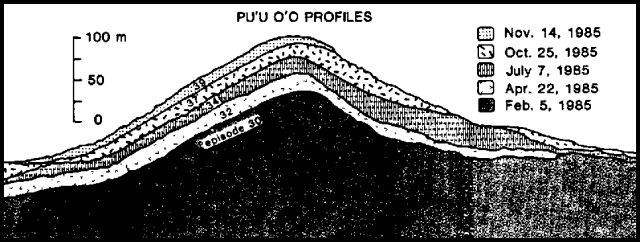Report on Kilauea (United States) — December 1985
Scientific Event Alert Network Bulletin, vol. 10, no. 12 (December 1985)
Managing Editor: Lindsay McClelland.
Kilauea (United States) 40th episode marks end of 3rd year of East Rift eruption
Please cite this report as:
Global Volcanism Program, 1985. Report on Kilauea (United States) (McClelland, L., ed.). Scientific Event Alert Network Bulletin, 10:12. Smithsonian Institution. https://doi.org/10.5479/si.GVP.SEAN198512-332010
Kilauea
United States
19.421°N, 155.287°W; summit elev. 1222 m
All times are local (unless otherwise noted)
"December ended the third year of Kīlauea's ongoing E rift zone eruption. The month was uneventful, with Pu`u `O`o maintaining an unusually long repose period after episode 39 on 13-14 November correlating with the low rate of inflation measured at the summit during most of the month.
"Harmonic tremor continued at a low level near Pu`u `O`o. On 21 December a short burst of moderate-amplitude tremor that lasted about 30 minutes originated from a mantle source about 40 km deep, SW of Kīlauea. The number of earthquakes of magnitude 2.5-3.5 on Kīlauea's S flank increased during the last two weeks of December.
EPISODE 40
Addendum: Episode 40 arrived with the New Year, beginning at 1309 on 1 January and lasting 13.5 hours. A narrow aa flow passed through the NE corner of Royal Gardens subdivision, but remained on top of older lava flows. The flow eventually stagnated about 9 km from the vent.
Summary of 1985 activity. "Eleven eruptive episodes occurred during 1985, each characterized by high fountains from the Pu`u `O`o vent and broad aa flows extending 3-7 km from the cone. Departures from the normal pattern were observed during the early stages of episodes 29, 35, and 39, when short-lived vents erupted at the base of the cone. During episode 35, fissure activity resumed after fountaining at the main Pu`u `O`o vent had ceased and continued for 17 days, producing a pahoehoe shield 26 m high at the base of Pu`u `O`o.
"Lava has covered 39 km2 since January 1983, and the total volume of lava exceeds 0.46 km3, surpassing all historic eruptions of Kīlauea. The Pu`u `O`o cone reached a height of 250 m in 1985 and is now the most prominent landmark on the E rift zone (figure 40). The single conduit is 20 m in diameter, with its top 110 m below the summit of the asymmetric cone.
 |
Figure 40. Profiles showing the growth of Pu`u `O`o since 5 February 1985, drawn from photographs taken from the 1123 cone, 1.5 km to the E. |
"Pu`u `O`o lava compositions showed marked intra-episode variation during episodes 30 and 31, with more mafic lava erupted late in the episode. These variations suggest that during these episodes the eruption drew down a compositionally zoned magma chamber. Over the long term, the lava compositions appear to have stabilized at nearly constant values, suggesting that less mixing with differentiated melts stored in the rift zone is taking place compared to early episodes.
Geological Summary. Kilauea overlaps the E flank of the massive Mauna Loa shield volcano in the island of Hawaii. Eruptions are prominent in Polynesian legends; written documentation since 1820 records frequent summit and flank lava flow eruptions interspersed with periods of long-term lava lake activity at Halemaumau crater in the summit caldera until 1924. The 3 x 5 km caldera was formed in several stages about 1,500 years ago and during the 18th century; eruptions have also originated from the lengthy East and Southwest rift zones, which extend to the ocean in both directions. About 90% of the surface of the basaltic shield volcano is formed of lava flows less than about 1,100 years old; 70% of the surface is younger than 600 years. The long-term eruption from the East rift zone between 1983 and 2018 produced lava flows covering more than 100 km2, destroyed hundreds of houses, and added new coastline.
Information Contacts: C. Heliker, G. Ulrich, R. Koyanagi, and R. Hanatani, USGS.

